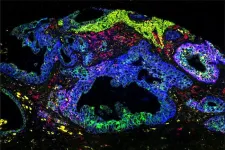(Press-News.org) A common mutation in the KRAS gene is associated with improved overall survival in pancreatic ductal adenocarcinoma (PDAC) compared with other variants, in part because the mutation appears to lead to less invasiveness and weaker biological activity, according to a multicenter study conducted at Weill Cornell Medicine, NewYork-Presbyterian, Memorial Sloan Kettering Cancer Center, and other institutions.
The research, published August 29 in Cancer Cell, demonstrates that KRAS mutations, which occur in about 95 percent of people who have PDAC, can vary, with KRAS-G12R, KRAS-G12D and KRAS-G12V being the most common alleles, and may provide doctors with valuable information about patient prognosis.
“We found that there are significant differences among these mutations,” said senior paper author Dr. Rohit Chandwani, an assistant professor in the departments of surgery and cell and developmental biology, and the Mildred L. and John F. Rasweiler Research Scholar in Cancer Research at Weill Cornell Medicine. Based on this information, “we suggest that clinical guidelines should be revised to recommend routine molecular testing in all patients with pancreatic cancer.”
Current National Comprehensive Cancer Network guidelines recommend molecular profiling for patients with later-stage, locally advanced or metastatic pancreatic cancer, but not for early-stage patients that have cancer confined to the pancreas.
Understanding how mutations affect the behavior of pancreatic tumors could potentially help guide treatment, said Dr. Chandwani, who is also a surgical oncologist at NewYork-Presbyterian/Weill Cornell Medical Center.
Dr. Caitlin McIntyre, a fellow at Memorial Sloan Kettering at the time of the study, and Dr. Adrien Grimont, a postdoctoral associate at Weill Cornell Medicine at the time of the study, were co-first authors on the paper.
A Deep Dive into Pancreatic Cancer
Pancreatic ductal adenocarcinoma accounts for more than 80 percent of pancreatic cancer cases, according to the National Cancer Institute. Overall, pancreatic cancer has a 5-year survival rate of about 13 percent, making it one of the deadliest malignancies. About 66,000 people in the United States will be diagnosed with the disease in 2024, according to the American Cancer Society.
To better understand the outcomes of early and late-stage pancreatic cancer, and their molecular underpinnings, the research team studied deidentified data from 1,360 patients who had pancreatic tumors removed at Memorial Sloan Kettering. Twenty-nine percent had early-stage cancer, meaning the cancer is confined to the pancreas, and 71 percent had late-stage tumors that had spread. Genomic sequencing was conducted in tumors from 397 patients to identify genetic mutations associated with PDAC.
The researchers also evaluated the tumors of 20 patients from NewYork-Presbyterian/Weill Cornell Medical Center and Weill Cornell Medicine using spatial transcriptomics, a sophisticated method for studying where gene expression occurs in the tumor tissue. RNA sequencing was used to study the gene activity in 100 tumors from patients at the Ontario Institute of Cancer Research. Patient consent and privacy was protected in all cases. The investigators then validated their findings on genetic mutations using mouse models.
Variations in KRAS Tumors Affect Outcomes
The researchers found that KRAS-G12D, the most common mutation occurring in 35 percent of study patients, was associated with aggressive cancer and the worst outcomes. The variant was also linked with increased rates of distant recurrence, or metastatic disease arising after an operation to remove a tumor. While further study is needed, patients who had tumors with these types of mutations could potentially benefit from chemotherapy as part of their treatment plan, Dr. Chandwani said.
KRAS-G12V, which occurred in about 30 percent of patients, was associated with better overall survival, as was KRAS-G12R, which was present in 15 percent of patients.
“KRAS-G12R is unique in that it is a mutation that seems to only occur in pancreatic cancer and not in the other cancer types associated with KRAS mutations, such as lung cancer,” said Dr. Chandwani, who is also a member of the Sandra and Edward Meyer Cancer Center and the Englander Institute for Precision Medicine at Weill Cornell Medicine.
In addition, KRAS-G12R was associated with increased rates of recurrence in and around where a pancreas resection was performed. Patients whose tumors had this mutation could potentially benefit from radiation, which is a local treatment, to decrease the likelihood of local recurrence. Additional studies are needed to assess this strategy, the investigators noted.
“When we approach treating these patients, we should be aware of their underlying KRAS mutations and aim to base our treatments on a thorough understanding of the patient- and tumor-specific factors that drive associated risk of various clinical outcomes,” Dr. Chandwani said. “This is an important next step.”
The research reported in this story was supported in part by the National Cancer Institute and the National Institute of Biomedical Imaging and Bioengineering, both part of the National Institutes of Health, through grant numbers U01CA238444 P30CA008748, and R01EB027498.
END
Researchers develop insights into KRAS mutations in pancreatic cancers
2024-10-02
ELSE PRESS RELEASES FROM THIS DATE:
New CAMH-led study highlights effective treatment for male postpartum depression
2024-10-02
(Toronto, Canada) – A new study from the Centre for Addiction and Mental Health (CAMH), in collaboration with leading researchers in Pakistan, has demonstrated the effectiveness of an integrated psychosocial intervention aimed at improving parenting skills and symptoms of depression. The treatment was effective for male postpartum depression (PPD) in a cohort of Pakistani fathers, improving both paternal mental health and child development outcomes.
“Male mental health, and especially postpartum depression in fathers, remains a stigmatized and understudied area,” says Dr. Ishrat Husain, the study's lead investigator and senior ...
Global study highlights the life-saving impact of Guideline-Directed Medical Therapy (GDMT) in heart failure patients
2024-10-02
Heart failure is a rapidly growing public health issue that can be difficult to manage on a global scale. But there are tools that exist that can improve outcomes, such as guideline-directed medical therapy (GDMT). New UCLA-led research highlights the important role that these guidelines can play in reducing mortality rates for individuals suffering from heart failure with reduced ejection fraction (HFrEF), a type of heart failure affecting an estimated 29 million people worldwide.
“These guidelines are being significantly underutilized in clinical settings globally and there ...
New method quantifies single-cell data’s risk of private information leakage
2024-10-02
Access to publicly available human single-cell gene expression datasets, or scRNA-seq datasets, has significantly enhanced researchers’ understanding of both complex biological systems and the etymology of various diseases. However, the increase in accessibility raises a greater concern about the privacy of the individuals who donated the cells and the likelihood of their private health details being shared without consent.
Previous studies on these privacy breaches have focused on bulk gene expression data sharing, where the average expression levels of genes are measured across a large population of cells from a tissue or sample rather than an individual cell. Because single-cell ...
Eyes on the fries: how our vision creates a food trend
2024-10-02
KEY POINTS
Human judgement of food images is influenced by judgements that precede it
Experiment tested reactions of more than 600 people making food choices
Highly relevant given widespread use of Uber Eats or phone-based menus
Finding could assist treatments for eating disorders or assist with food marketing
Research at the University of Sydney has revealed that we don’t judge food simply on its merits but are influenced by what we have seen beforehand, a cascading phenomenon known as ‘serial dependence’.
The research, published today in the high-impact journal Current Biology, was conducted by Professors David Alais ...
UVM scientist maps fruit fly brain
2024-10-02
A team of scientists supported by the National Institutes of Health (NIH)’s The BRAIN Initiative®, including Davi Bock, Ph.D., Associate Professor of Neurological Sciences at UVM’s Robert Larner, M.D. College of Medicine, recently made a substantial advancement in neurobiological research by successfully mapping the entire brain of Drosophila melanogaster, more commonly known as the fruit fly.
The study, titled “Whole-brain annotation and multi-connectome cell typing of Drosophila,” recently published ...
Bridging the gap: how pragmatic trials can better serve healthcare systems
2024-10-02
Boston, MA – A new thought piece led by the Harvard Pilgrim Health Care Institute with collaborators from Duke University and Kaiser Permanente Washington Health Research Institute highlights the challenges facing healthcare researchers and decision makers in the quest to improve population health in a constantly evolving healthcare landscape. The authors offer strategies to enhance the effectiveness of pragmatic clinical trials and increase their impact on real-world healthcare settings.
The Viewpoint appears October 2 in JAMA.
Pragmatic clinical trials, designed to inform health ...
UChicago scientists decode key mutation in many cancers
2024-10-02
Inside every cell, inside every nucleus, your continued existence depends on an incredibly complicated dance. Proteins are constantly wrapping and unwrapping DNA, and even minor missteps can lead to cancer.
A new study from the University of Chicago reveals a previously unknown part of this dance—one with significant implications for human health.
In the study, published Oct. 2 in Nature, a team of scientists led by UChicago Prof. Chuan He, in collaboration with University of Texas Health Science Center at ...
NYU Langone awarded $1.6 million to investigate Alzheimer’s & Parkinson’s progression through the eye
2024-10-02
Researchers at NYU Langone Health were awarded $1.6 million from the National Institutes of Health (NIH) to investigate changes in the eye that may indicate early signs of Alzheimer’s disease and Parkinson’s disease.
The award, OT2OD038130, recognizes the eye as a part of the brain and its role as a window into cognitive and visual health. After the initial $1.6 million award, the grant may renew an additional two years, for a total of $4.8 million as part of the NIH Common Fund Venture Program’s new Oculomics Initiative. Oculomics is a relatively new term to describe the integrative use of technology and ...
Missing link found in gamma emission phenomena from thunderclouds
2024-10-02
Groundbreaking Discoveries in Gamma-Ray Emissions from Thunderstorms
In the recent edition of Nature, groundbreaking results about the gamma-ray emissions produced during thunderstorms are presented. Overall, these findings reveal that gamma-ray emission from thunderclouds is much more complex, diverse, and dynamic than previously thought. Understanding these phenomena is crucial to uncovering the secrets of lightning.
Flickering Gamma-Ray Flashes: A New Discovery
Entitled “Flickering Gamma-Ray Flashes, the Missing Link between Gamma Glows and TGFs,” the paper by Østgaard et al. [2024] reports unique observations of a new phenomenon called Flickering Gamma-Ray ...
Social media users’ actions, rather than biased policies, could drive differences in platform enforcement
2024-10-02
A new paper, “Differences in misinformation sharing can lead to politically asymmetric sanctions,” published today in Nature suggests that the higher quantity of social media policy enforcement (such as account suspensions) for conservative users could be explained by the higher quantity of misinformation shared by those conservative users — and so does not constitute evidence of inherent biases in the policies from social media companies or in the definition of what constitutes misinformation.
Written by ...





